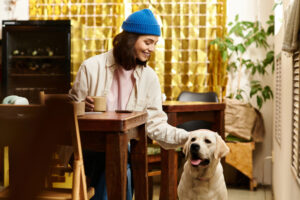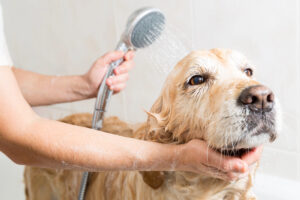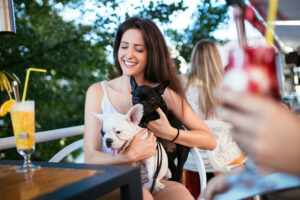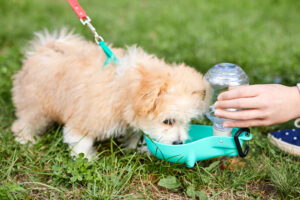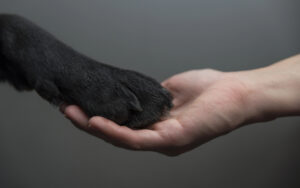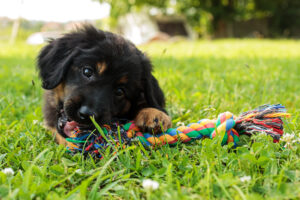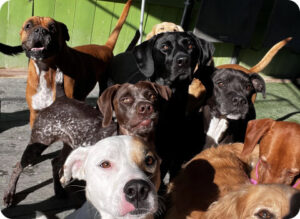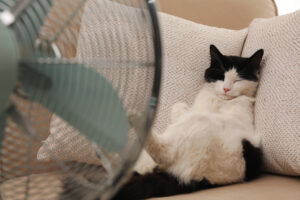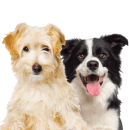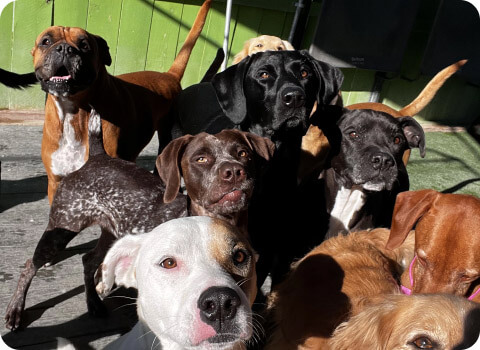
Introducing a New Pet to Daycare: Step-by-Step Guide for First-Time Dog Parents
Bringing your dog to daycare for the first time can be an exciting step for both of you. It’s a chance for your pup to make new friends, build confidence, and enjoy safe and supervised play while you’re away. And for you, it offers peace of mind knowing your dog is cared for in a stimulating, structured setting.
With the right preparation and a calm, confident approach, your pet can adjust smoothly and thrive in their new social routine. Whether you’ve just adopted a puppy or rescued an older dog, this guide walks you through each step of the daycare introduction process.

Boarding Clients!*Discount does not apply during holiday/peak rate periods.

Step 1 - Choose the Right Dog Daycare
Finding a daycare that fits your dog’s needs starts with knowing what to look for. Not all facilities are the same, and choosing the right one makes a big difference in your dog’s experience.
Look for a daycare that is licensed, clean, and professionally staffed. The best daycares have handlers trained in dog behavior, CPR, and group management.
Ask how they introduce new dogs to the pack. A structured onboarding process, like a temperament test or slow introductions, helps reduce stress and ensures safer play.
Key things to ask about:
- Group sizes and how dogs are separated (by age, size, temperament)
- Supervision: Are handlers present during all group play?
- Outdoor vs indoor space: Does your dog get fresh air and room to move?
- Emergency plans and vet access
- Vaccination and health requirements
In places like San Diego, a daycare with outdoor space, like Fon Jon Pet Care, gives your pup a chance to play in the fresh air all year long.
If they offer a free trial day, take advantage of it. It’s a helpful way to see if the environment works for your dog before making a full commitment.
Step 2 - Tour the Facility Without Your Dog First
Before your dog’s first day, schedule a quick tour on your own. This gives you peace of mind and lets you ask questions without distractions.
What to look for during your visit:
- Clean, odor-free play areas
- Calm, happy dogs with adequate space
- Friendly and knowledgeable staff
- Separate zones for active, senior, or shy dogs
- Supervised group play, not just free-for-all chaos
Ask how new dogs are introduced to the group and how often dogs are given breaks. Daycare should be fun, but also restful and safe.
If the staff takes time to explain routines, walk you through safety steps, and seems genuinely interested in your dog’s needs, that’s a great sign.
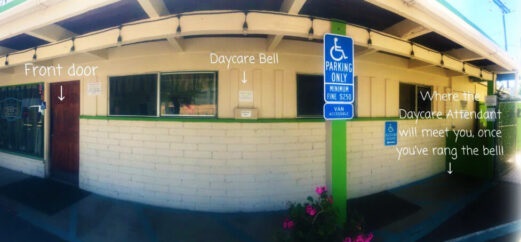
Step 3 - Book a Half-Day or Trial Visit
Easing your dog into daycare slowly is one of the best things you can do. Start with a half-day or short trial session to test the waters.
Why not dive right in? Because a full day in a new environment with new dogs, new smells, and new humans can be a lot to take in. A half-day gives your dog time to explore without becoming too overstimulated or overtired.
Pay attention to how your dog acts after the visit. It’s totally normal for them to be tired. Look for signs they had a good time, like eating, sleeping, and returning to their normal behavior within a few hours.
What you don’t want is a dog that seems overly stressed, avoids interaction, or has a sudden shift in behavior like whining excessively or hiding. If that happens, talk to the daycare staff and see how the day went. Sometimes dogs need a few short visits to warm up.
Use this time to observe, learn, and adjust as needed. Starting small makes it easier to build a positive daycare routine long-term.
Step 4 - Prep Your Dog at Home Before Drop-Off
Before your dog’s first official day at daycare, it helps to do a little practice at home. This step is especially important for puppies or rescue dogs who may be adjusting to a new routine.
Start by helping your dog get used to being away from you for short periods. Even 15 to 30 minutes of crate time while you leave the room or step outside can build confidence.
If your dog struggles with this, try using positive reinforcement, such as treats, toys, or a chew toy, to keep them occupied.
Work on basic obedience commands like:
- “Sit”
- “Come”
- “Leave it”
- “Stay”
These cues make it easier for handlers to manage group play and help your dog feel more in control.
You can also increase your dog’s comfort around other dogs. Take them on leashed walks near calm dogs, visit pet-friendly spaces, or allow polite greetings at the park. These small exposures add up to better social behavior.
Car rides are another thing to practice. If your dog gets nervous in the car, take short drives and reward them with praise or treats. That way, the trip to daycare won’t feel like a big deal.
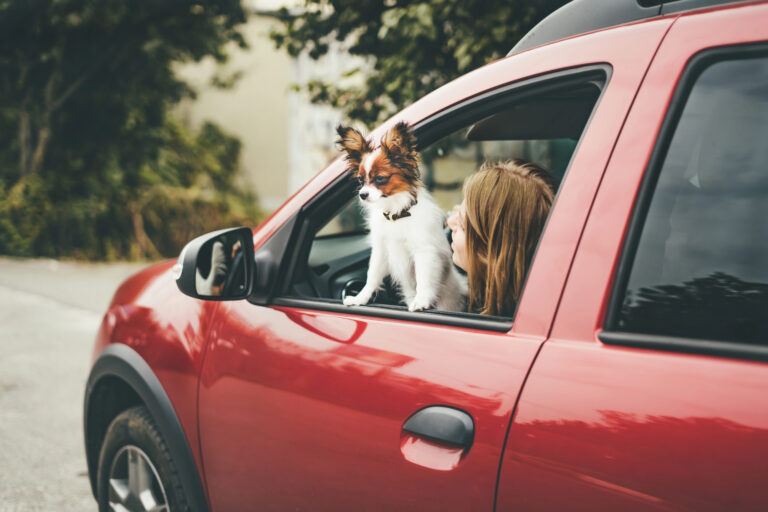
Step 5 - Pack What Your Dog Needs
A smooth first day also depends on what you send with your dog. Check with the daycare for their exact requirements, but here are some basics most places ask for:
- Up-to-date vaccination records: Rabies, Bordetella, and distemper are commonly required
- Emergency contact information: Include your number and your vet’s contact details
- Food or treats(if needed): Some daycares feed dogs lunch or reward calm behavior with small snacks
- Comfort item (optional): A small blanket or toy from home may help anxious pups settle in
Label anything you bring so it doesn’t get mixed up with other dogs’ items. It’s also smart to skip anything too valuable; things can get chewed or misplaced during play.
Step 6 - Drop-Off with Confidence
Dogs are great at picking up on your energy. If you’re nervous or hesitant at drop-off, there’s a good chance your dog will feel the same way.
Keep the goodbye short and upbeat. No drawn-out hugs or sad looks. A calm, confident goodbye tells your dog, “This is safe, and I’ll be back.”
Most daycares have staff ready to guide your dog inside, which helps the hand-off go quickly. Trust the team. You’ve done your part, and now it’s time to let the pros help your dog adjust.
In fact, studies show that dogs who regularly engage in social activities, like those at dog daycare, tend to show fewer signs of separation-related stress compared to more isolated dogs.
So even if your dog is a little nervous at first, this kind of structured social time can help them feel more secure over time.
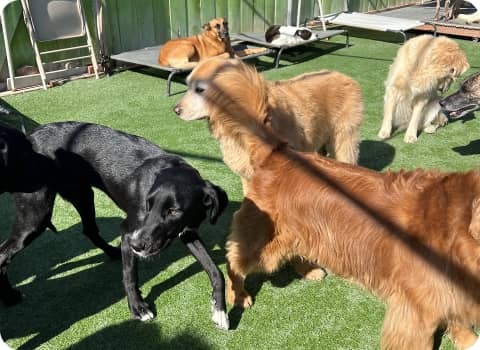
Step 7 - Check In and Observe Post-Daycare Behavior
After your dog’s first day, it’s helpful to check in with the staff. Ask how your dog behaved during playtime, how they responded to new dogs, and if they took breaks or rested.
When you get home, watch for signs that your dog had a positive experience:
- Relaxed body language
- Eagerness to eat and rest
- Calm behavior after a short nap
It’s normal for dogs to be tired or a bit clingy after their first visit. What you don’t want is ongoing signs of distress like hiding, trembling, or refusing to eat. If you notice anything off, talk with the daycare. They may recommend another short session or adjusting how your dog is introduced.
Remember, every dog adjusts at their own pace. Some are ready to play within minutes, while others need a few visits to feel comfortable. What matters most is building a positive routine, one step at a time.
Final Words
Introducing your dog to daycare is a big step, and one that can lead to a happier, more confident pup. With the right preparation, a patient approach, and a daycare that puts your dog’s comfort first, most pets adjust beautifully.
Here’s a quick recap:
- Choose a daycare with experienced staff, clean facilities, and clear safety policies
- Start small with a short visit or half-day trial
- Practice routines at home and bring the right supplies
- Keep drop-offs calm and confident
- Check in with staff and observe your dog’s behavior afterward
Whether you have a new puppy, a shy rescue, or just want your dog to enjoy more playtime and socialization, Fon Jon Pet Care makes it easy. With outdoor play yards, experienced handlers, and a free first-day trial, it’s a great place to help your dog feel right at home in San Diego.
Ready to give it a try? Book your dog’s first FREE day of daycare at Fon Jon today, let’s help them feel right at home. Our team is here to walk you through every step and make the experience easy and stress-free.

faqs
What if my dog is shy or nervous?
That’s totally okay. Many daycares have slow introduction plans and smaller playgroups for dogs that need extra time. With patient guidance, even shy dogs usually warm up.
How long does it take for a dog to adjust to daycare?
It depends on the dog. Some feel at ease within a visit or two, while others may need a few weeks of shorter stays. Consistency helps build comfort and trust.
Can I stay with my dog during their first day?
Most daycares recommend a quick drop-off. Staying can actually make it harder for your dog to adjust. A confident goodbye helps set a positive tone.
At what age should a puppy start daycare?
Once your puppy is fully vaccinated, usually around 12 to 16 weeks, they can start daycare. It’s a great way to support early socialization.
Will my dog be overwhelmed by other dogs?
Good daycares separate dogs by size, energy, and personality. If your dog needs space, staff can guide slow introductions or give one-on-one attention.
What should I do if my dog seems tired after daycare?
Tired is normal! Daycare is mentally and physically stimulating. Let them rest, keep their routine gentle, and check in with the staff if anything feels off.




